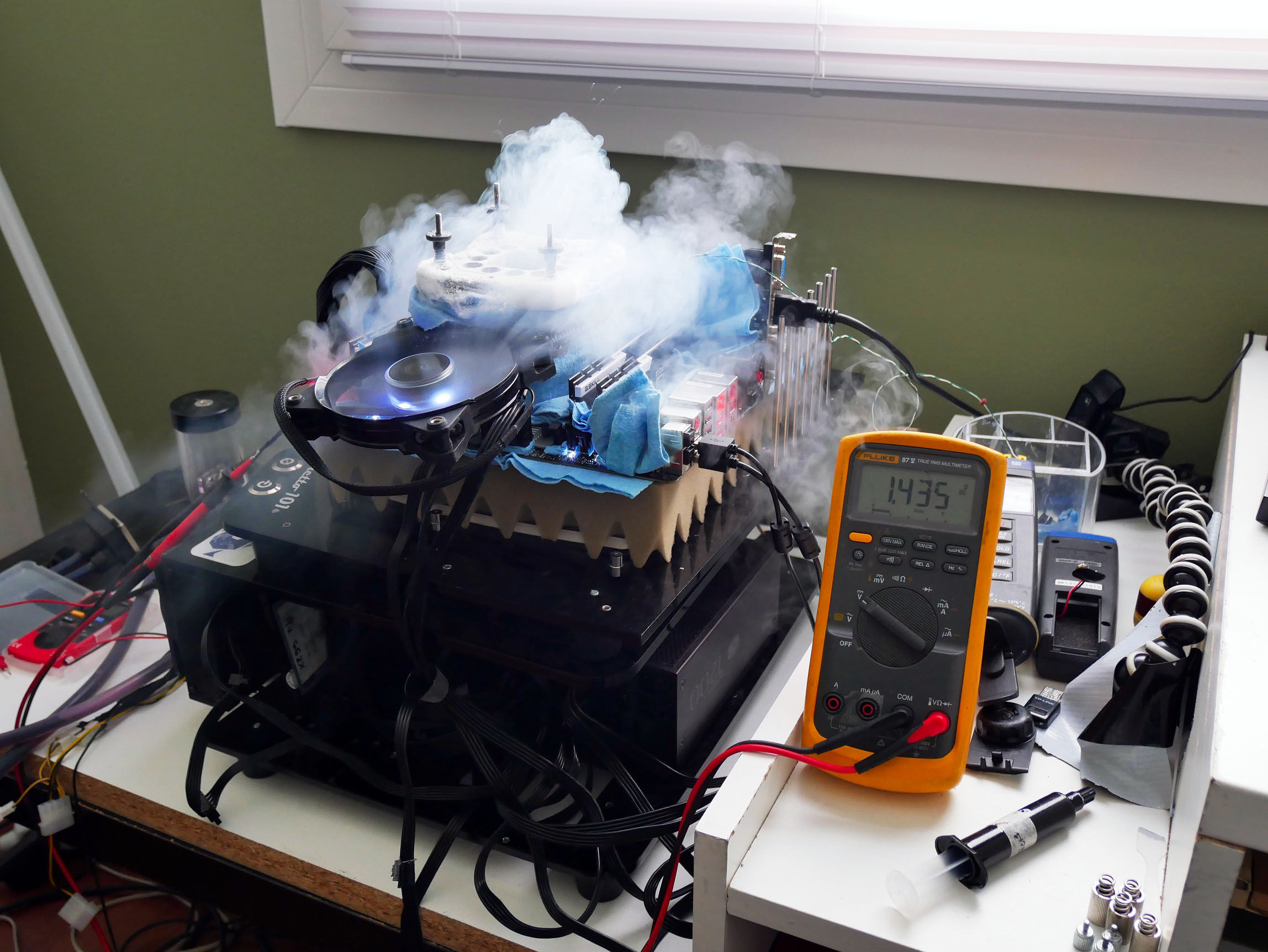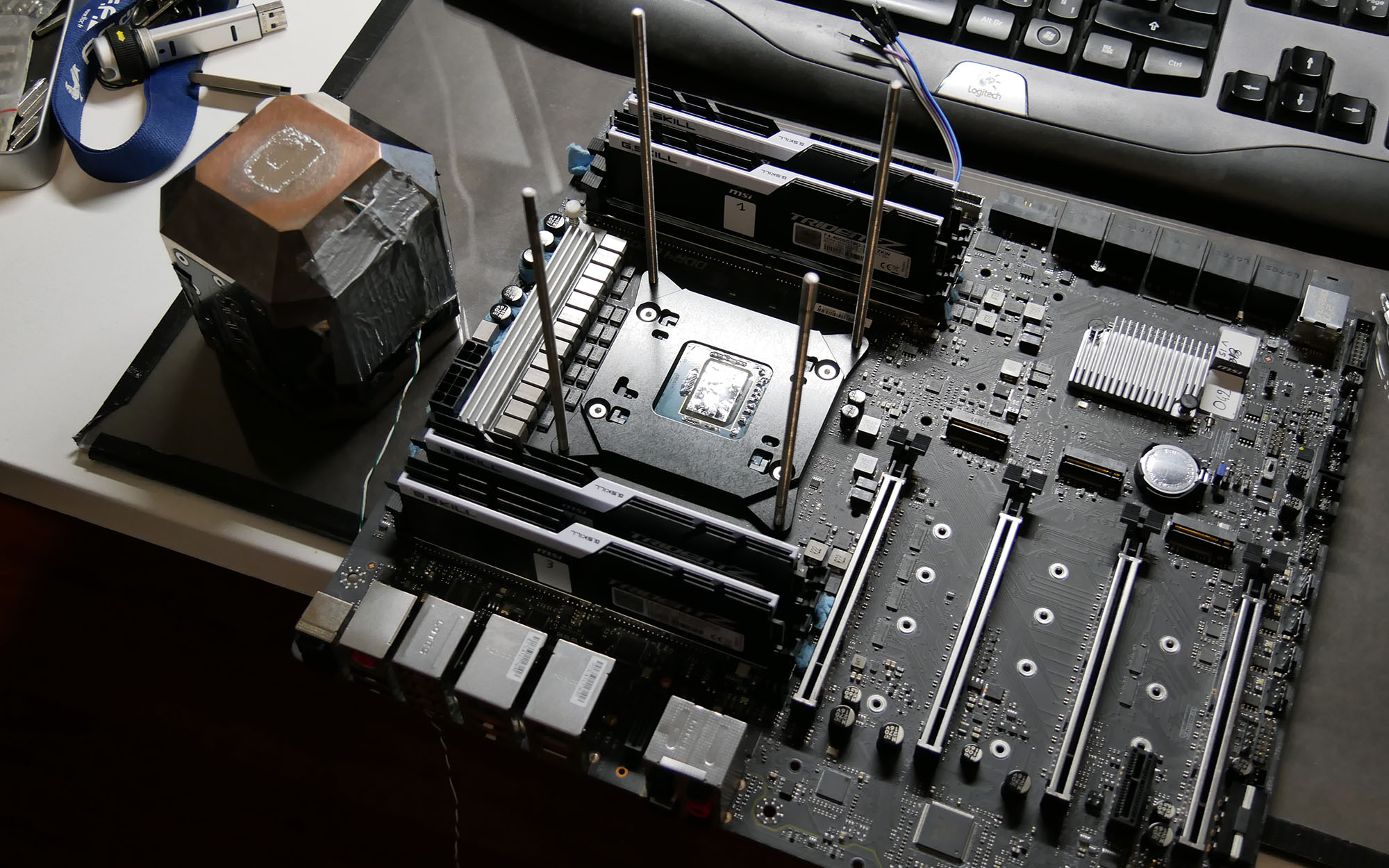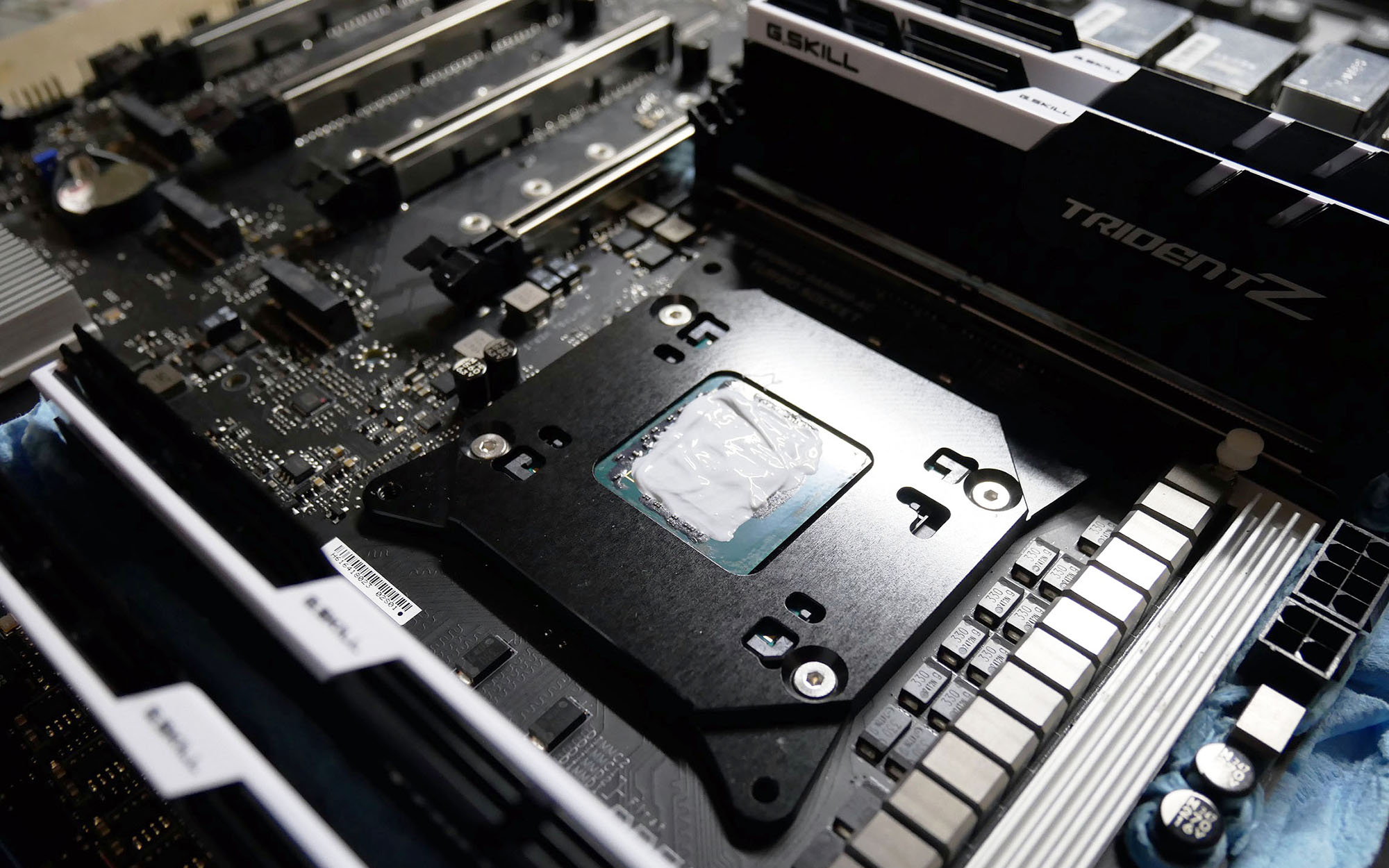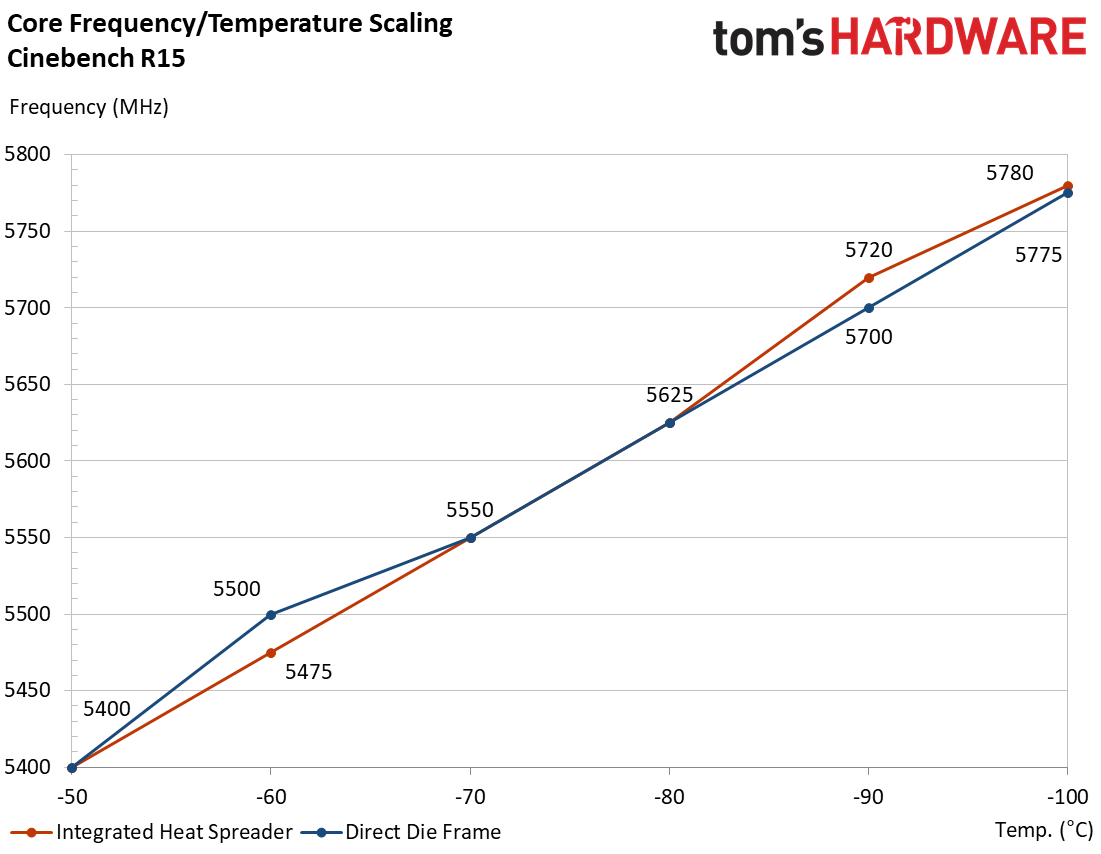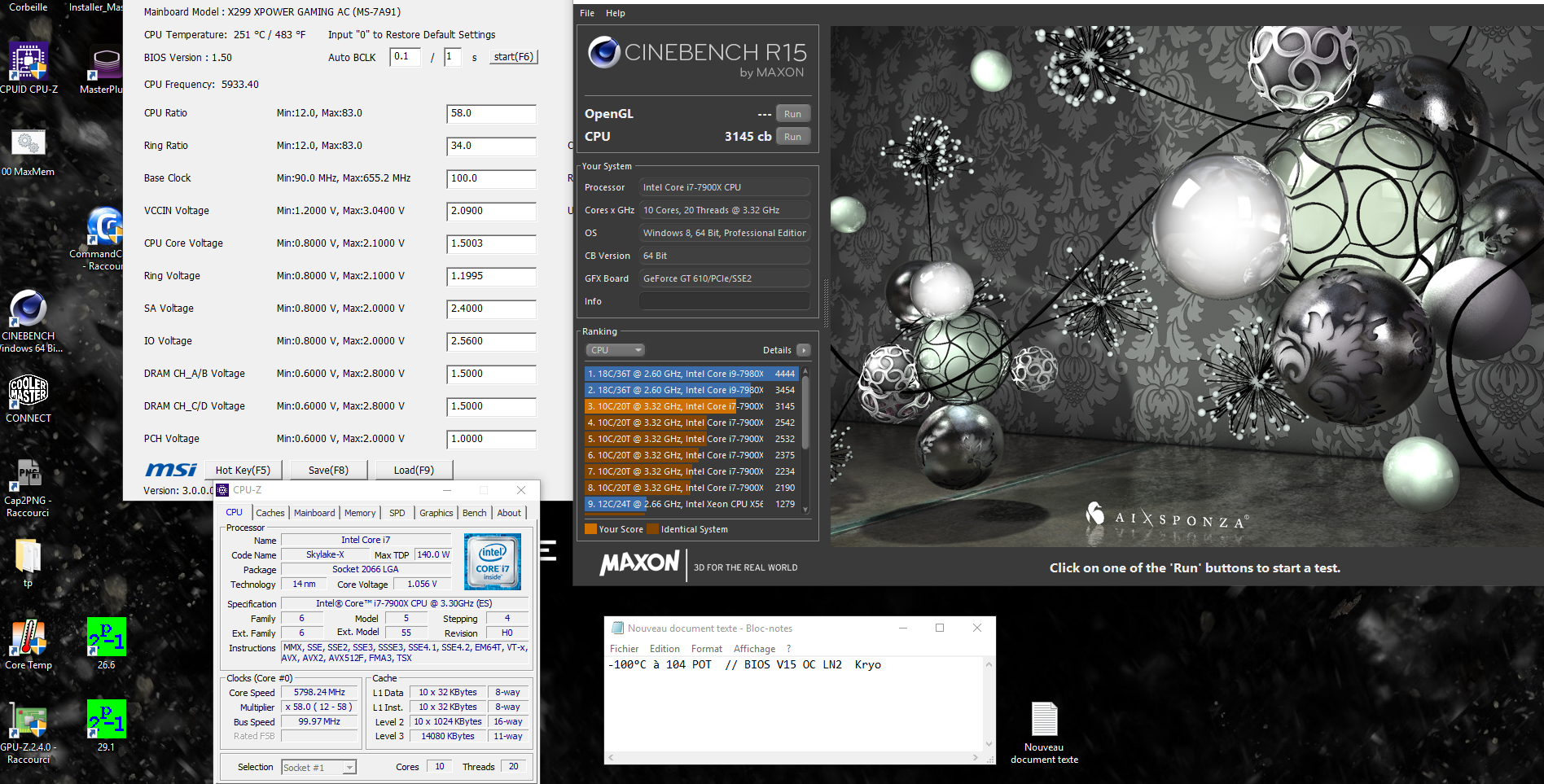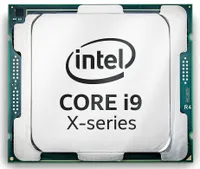Overclocking Intel's Core i9-7900X CPU Up to 5.8 GHz
The Main Event: Overclocking With LN2
With all of that practical information out of the way, it's time to set aside our water-cooling loop and set up for liquid nitrogen.
Conductonaut versus Kryonaut
At ambient temperatures, Conductonaut performs better than classic thermal compounds. But experience tells us that it doesn't fare well under the influence of extreme cold. With this in mind, we maintained 2.1V Vccin, 1.4V Vcore, and 4800 MHz core clock rate settings.
- With the cooling pot's base at 20°C, Core Temp indicated a power consumption of 330W and core temperatures ranging from 80 to 98°C.
- At 0°C, power consumption reportedly dropped to 303W. That was naturally a surprising result, so we confirmed it with the monitoring capability of our Cooler Master MasterWatt Maker 1200. Lowering the cooling pot's temperature by 20°C also dropped the core temperatures by as much as 30°C.
- At -20°C, power consumption fell as low as 285W. The cores cooled off by another 25°C.
- At -40°C, our power consumption measurement was 275W (or 55W less than our starting point). The hottest core measured 17°C, while the coolest was at 1°C.
- At -60°C, the system became unstable after we observed rapid and significant core temperature increases. This is our sign that the thermal paste stopped doing its job.
This test confirmed that Conductonaut, a high-performance paste at ambient temperatures, doesn't work below -60°C. Our experiment also gave us several interesting data points to show the direct correlation between CPU's operating temperature and power consumption. Although it's less effective than Conductonaut at ambient temperatures, Kryonaut is a better choice for extreme overclocking.
Direct Die Frame versus IHS
Next, we set out to see if the benefits of direct-die cooling mapped over to overclocking with liquid nitrogen.
Although we did our best to record accurate and precise results, bear in mind that it's very difficult to achieve repeatability with LN2.
With the cooling pot at -50°C, our DDF performs a lot like the Core i9 with its IHS intact. At the next temperature increment, direct-die cooling takes a small lead. But at -70°C, where we thought the gap would widen even further, both approaches converge once again. Tests at -80, -90, and -100°C resulted in similar observations. Whether you use direct-die cooling or a heat spreader between the die and cooling pot, the outcome is near-identical.
Maximum Frequency
The highest stable frequency we reached that'd still run Cinebench R15 was 5800 MHz. Not bad for a CPU that gave us so many problems at launch using more mainstream approaches to cooling.
Get Tom's Hardware's best news and in-depth reviews, straight to your inbox.
MORE: Best CPUs
MORE: Intel & AMD Processor Hierarchy
MORE: All CPUs Content
Current page: The Main Event: Overclocking With LN2
Prev Page Optimized Overclocking And Load-Line Calibration Next Page Conclusion-
vasras Another excellent article, with temp, power and voltage scaling at various cooling/contact methods. Thank you.Reply -
Reynod I bet crashman is spewing he didn't get this gig ... :) Well done ... nice work PresencePC!!Reply -
AgentLozen Very interesting article. I liked your explanations of the expert bios settings on the first page. I usually just ignore the stuff in the bios I don't understand.Reply
While I enjoyed reading all of this, it's not something that would help me personally. I leave my CPU underclocked to >1Ghz so I can feel like I'm back in the 90's again. -
10tacle Besides the obvious awesome overclock detail story and results, I like the fact articles remind us of Intel's failure to use the highest quality manufacturing/assembly principles on their top tier CPUs. Especially their x-Series chipsets. There is no excuse for a near-$1,000 chip to have such poor thermal management quality from the factory. I mean how stupid is that.Reply
One of Intel's strongest advantages over AMD for many years now has been their overclocking ability to push them beyond comparable AMD chips. But not only that, to allow future overclocking headroom for keeping the platform longer when newer and faster replacement generation chipsets are introduced. Poor thermals remove those advantages and not many people want to risk messing up their four-figure chip by de-lidding mods.
I hope Intel takes articles like these in notice and will step it up for their next generation of high end i7 and i9 models. -
g-unit1111 Reply21039131 said:Why didn't you just use the EVGA Dark?
I'm guessing because the RAM limit is only 64GB? Where every other X299 board the limit is 128GB. That would make a huge difference in getting the higher speeds. -
Giroro I don't know much about extreme overclocking, tell me more about this "cooling pot".Reply
It is there to hold the liquid nitrogen and separate it from the die? Is there a reason you don't submerge the entire die in liquid nitrogen instead and lose the thermal compound entirely?
It looks like it has a significant copper plate on it. If you are already going through such extreme lengths, then why not use silver and make the plate as thin as possible?
Also, it's pretty interesting that cleaning the processor did not help with the delid, considering that people delidding older i5/i7s say the thickness of that glue is the primary reason that a delid is effective. -
AgentLozen ReplyGiroro said:it's pretty interesting that cleaning the processor did not help with the delid
I thought the same thing. I was expecting the processor to benefit from the cleaning. -
Giroro Reply21039536 said:Besides the obvious awesome overclock detail story and results, I like the fact articles remind us of Intel's failure to use the highest quality manufacturing/assembly principles on their top tier CPUs. Especially their x-Series chipsets. There is no excuse for a near-$1,000 chip to have such poor thermal management quality from the factory. I mean how stupid is that.
One of Intel's strongest advantages over AMD for many years now has been their overclocking ability to push them beyond comparable AMD chips. But not only that, to allow future overclocking headroom for keeping the platform longer when newer and faster replacement generation chipsets are introduced. Poor thermals remove those advantages and not many people want to risk messing up their four-figure chip by de-lidding mods.
I hope Intel takes articles like these in notice and will step it up for their next generation of high end i7 and i9 models.
The cynic in me makes me think that the primary reason Intel switched to thermal paste is for planned-obsolescence and to prevent people from using old platforms for a long time. I'm pretty sure Intel wants to sell you a new processor as often as possible.
Cheaper manufacturing, reduced ability to overclock, Thermal paste that will probably dry out and slow down the CPU within a few years (which will make new models look faster by comparison) ... All these things are positives to a marketing executive.
Hopefully AMD becomes even more competitive, because workmanship isn't going to improve until Intel can correlate their drop in quality with a loss of profit. -
cryoburner Reply
Isn't that the point? If someone messes up their CPU, they have to buy a new one. And delidding voids the warranty, helping Intel more easily recognize and avoid paying for the replacement of chips that have failed as a result of high overclocks. And of course, if people are deterred from overclocking their CPU, they may have more reason to upgrade to a faster one a few years down the line. Intel doesn't want people "keeping the platform longer", and they know that those looking for the highest overclocks will currently go with them either way. Considering it can cost around $5 or so extra to solder a CPU, and most people won't be overclocking, they undoubtedly don't see much point in spending the money to do so.21039536 said:Poor thermals remove those advantages and not many people want to risk messing up their four-figure chip by de-lidding mods.
AMD is willing to, since they currently can't achieve quite the same level of clock rates on their CPUs at the high-end, and know they need to do other things to make their chips more competitive with the market leader, like adding extra cores and using solder.
